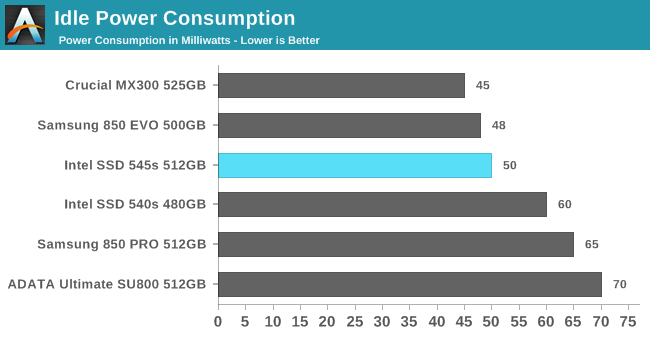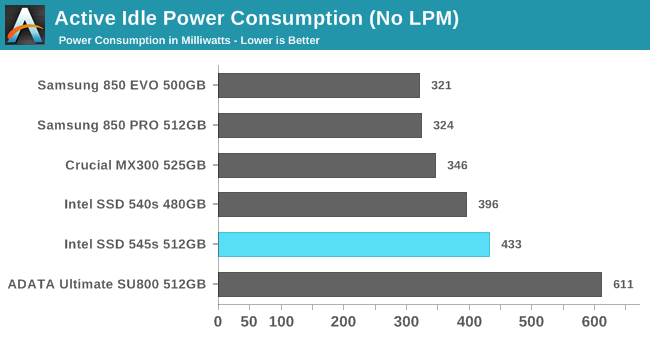The Intel SSD 545s (512GB) Review: 64-Layer 3D TLC NAND Hits Retail
by Billy Tallis on June 27, 2017 6:00 AM ESTIdle Power Consumption
Since the ATSB tests based on real-world usage cut idle times short to 25ms, their power consumption scores paint an inaccurate picture of the relative suitability of drives for mobile use. During real-world client use, a solid state drive will spend far more time idle than actively processing commands. Our SYSmark 2014 SE test covers this case, but because our testbed is a desktop system the SSD's contribution to the total power usage is small and hard to isolate from ordinary variation between test runs.
Our testbed doesn't support the deepest DevSlp power saving mode that SATA drives can implement, but we can measure the power usage in the intermediate slumber state where both the host and device ends of the SATA link enter a low-power state and the drive is free to engage its internal power savings measures.
We also report the drive's idle power consumption while the SATA link is active and not in any power saving state. Drives are required to be able to wake from the slumber state in under 10 milliseconds, but that still leaves plenty of room for them to add latency to a burst of I/O. Because of this, many desktops default to either not using SATA Aggressive Link Power Management (ALPM) at all or to only enable it partially without making use of the device-initiated power management (DIPM) capability. Additionally, SATA Hot-Swap is incompatible with the use of DIPM, so our SSD testbed usually has DIPM turned off during performance testing.

With SATA device-initiated link power management enabled, typical idle power consumption drops by a factor of ten, straining the resolution of our power meter. All of these SATA SSDs have very effective low-power idle states, but the 545s does show clear improvement over the 540s and Intel is now quite close to the Crucial MX300 and Samsung 850 EVO.

The Samsung drives have the best active idle power levels of this bunch, and the Crucial MX300 is not far behind. The Silicon Motion-based Intel 540s, 545s and ADATA SU800 are worst, though only the SU800 is trailing by a large margin. The 545s does draw more power than the 540s, which is not what we would expect from an updated controller design.
Idle Wake-Up Latency
Idle power consumption is not the only important metric of a SSD's power management capabilities. Devices cannot transition in and out of low-power states instantly. It takes time for components to switch back to higher clock speeds and resynchronize their data links to the rest of the system. At the extreme end, the several seconds it takes a hard drive to spin up obviously has a major impact on system responsiveness, and consequently operating systems have to be very conservative about when to put a hard drive to sleep, typically requiring at least several minutes of idle time during which the hard drive is wasting power.
The idle power transition time of solid state drives exists on a very different time scale, but it still matters to systems that are trying to minimize power consumption without sacrificing too much performance. When a SSD only takes a few milliseconds to enter and leave a power saving state, those power saving states can be used far more often, even during sustained interactive use like gaming. The cost of this approach is that far more I/O operations will incur the wake-up latency penalty.
Our equipment is not able to measure how long it takes a SSD to enter a low-power state; this would require very precise synchronization between the CPU and a high-resolution power meter. Timing how long a SSD takes to leave a low-power state is simple: perform one read operation every few seconds, and compare the latency with and without power management enabled. The difference, reported below, includes time taken to reestablish the SATA link and for the SSD to wake up, but does not include the time spent actively reading data from the flash memory since that will be the same whether or not the SSD had just been in a low-power state. Thus, this test is mostly a measure of the SSD controller and its firmware.

The Crucial MX300 has pretty good power consumption both at idle and under load, but its Marvell controller takes far longer to wake up from idle than its competition. At about 3.4ms, the MX300 is almost five times slower to wake up than the ADATA SU800, which has higher idle power consumption. The Intel 545s is a bit on the slow side at 1.4ms, about twice the wake-up latency of the ADATA SU800 or the Intel 540s. The total read latency for the 545s with power management enabled is just over 2.2ms.










74 Comments
View All Comments
cybertec69 - Tuesday, June 27, 2017 - link
There is no NANDI shortage, it's all a bunch of nonsense, it's nothing more than price gouging.patrickjp93 - Wednesday, June 28, 2017 - link
Yes there is. Factories are converting all of their equipment from planar to 3D. It takes time just to move everything, then tune yields, and boost to mass production. On top of that, NAND demand has doubled in the past 2 years. There is a very real shortage.AnTech - Wednesday, June 28, 2017 - link
How does it compare to the current gold standard (Samsung Portable SSD T3)?Samsung Portable SSD T3 is so amazing that keeps cold even when booting Mac and working from it all day long. Really remarkable and amazing!
BTW, bring much larger sizes of 4 TB and more! And much cheaper prices!
Hurr Durr - Wednesday, June 28, 2017 - link
>portable ssd>gold standard
In what, waiting for the file transfer to finish?
mayankleoboy1 - Wednesday, June 28, 2017 - link
Regarding the "Random read performance" metric as outlined in http://www.anandtech.com/show/9009/ocz-vector-180-...Do you think it makes more sense to give 50%:37.5:12.5% weights to QD1:QD2:QD4 , instead of taking simple average?
Doubleslash - Wednesday, June 28, 2017 - link
Can you please do some meaningful IOPS, bandwidth and latency tests with fio or iozone? Things like sustained random 4k/8k/16k IOPS and large-block (64k/256k/512k/1024k) sequential read and write throughput are much better suited to compare wear-leveling, cache and controller performance.You can omit these SYSmark test as they are pretty useless. As the result indicates they do not stress the disk subsystem very much.
jardows2 - Wednesday, June 28, 2017 - link
Reviewing these charts, this product falls between the EVO and the MX300, but only slightly better than the MX300. It appears that the only realistic differences between the 545 and the MX300 are seen when the MX300 is full. Who uses their drives full? The current $20 price premium of the 545 over the MX300 doesn't seem worth it for the small gains, unless Intel can improve performance with some firmware updates.Wolfpup - Wednesday, June 28, 2017 - link
Wish companies would release MLC if not SLC drives too... Really not excited about being stuck with TLC.And I'm YEARS past caring about the performance of any of these drives, unless there's something weird about them. I care about reliability.
Hell, a few of my systems (not main systems, but still) boot if 5400RPM mechanical drives, and are fine. I really don't care if word launches in 0.0001 seconds or 0.0002 seconds or whatever LOL
piiman - Saturday, July 22, 2017 - link
"I really don't care if word launches in 0.0001 seconds or 0.0002 seconds or whatever LOL"Blasphemy!
alpha754293 - Thursday, June 29, 2017 - link
I look forward to seeing how it performs on the random write tests...I have four Intel 540 series 1 TB SSD drives at home and they're ok. I traded off speed for capacity and cost, and I didn't know that this was launching, so this was sort of a welcomed surprise.